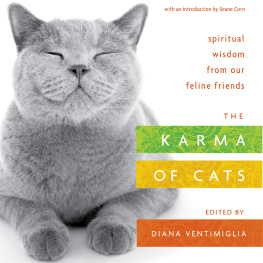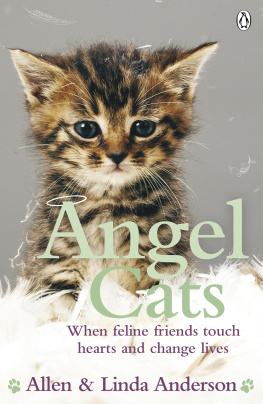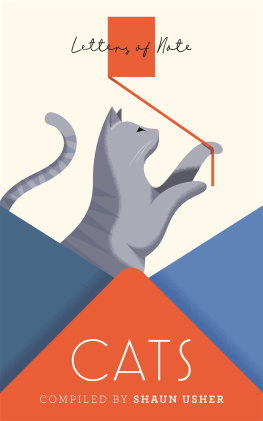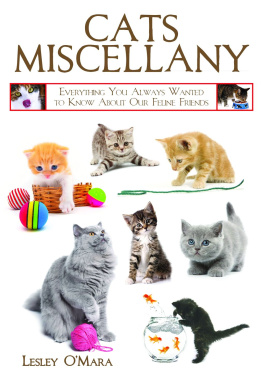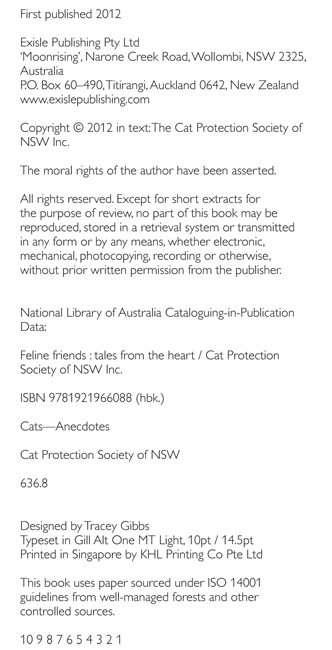INTRODUCTION
Man domesticated the cat. And the cat, being a courteous creature, returned the favour.
Anon
Jam took her own sweet time finding a home. A pretty female ginger tabby (only about a quarter of all ginger cats are girls) shed come to Cat Protection as a stray mum. She raised her kittens with care and love and they all quickly found forever homes. She enjoyed life in our adoption centre. She was easygoing and relaxed, and loved the attention of volunteers and staff. She got on well with the other cats. So why was she with us for thirteen months?
The answer is some 10,000 to 12,000 years old: we didnt choose cats, they chose us. As it was then, so it is today, and thus Miss Jam would not make herself available or appealing to potential adopters ... until she found the people she wanted to live with.
Now known as Ginger Rogers, she enjoys a life of pleasant sophistication in the Sydney pied--terre of a couple who adore her. She found what she was looking for.
***
The development of agriculture is believed to have started around the Fertile Crescent (todays Middle East) about 12,000 years ago. Dogs had been companions of people before this; they had been domesticated and helped with hunting and protection, and didnt object to moving from place to place. When people progressed from hunting to agriculture and the storage of surplus grain, this attracted mice and their natural predators, cats.
Genetic studies show that all modern domestic felines are descendants of the species Felis silvestris catus (cat of the woods) commonly known as a wildcat. There are five subspecies of wildcatSardinian (Felis silvestris lybica); European (Felis silvestris silvestris); Central Asian (Felis silvestris ornata); Sub Saharan African (Felis silvestris cafra); and Chinese Desert (Felis silvestris bicti). Look at any of these cats and it takes no imagination to picture them in front of a heater, purring. But while the Scottish Wildcat looks just like a large Mackerel Tabby, it is a true wild species (and protected as such).
The studies show that modern day moggies strongest ancestral link is to the sub-species Felis silvestris lybica. This is interesting because it suggests that regional wildcats werent locally domesticated but that the first domestic cats were exported along with the skills of agriculture. Genetic evidence also reveals that those domestic cats didnt mind a fling with their new neighbours. This is no surprise to anyone whos lived with a cata domestic cats wild side has never actually been tamed, it simply rarely reveals itself.
So there they were, Felis silvestris lybica, watching as people formed communities and stored the harvest, seeing the shelters being built and the warm fires being lit, and certainly not missing that very convenient food source (Mus musculus). As those people discovered the grain protection benefits of cats, the cats discovered the benefits of housing and human attention. Feline beauty was on their side: its theorised that kittens big eyes and snub noses evoke a nurturing response in people thats also biologically triggered by babies. The cats who adapted to living with people in human settlements thrived and their relatives are in our lounge rooms today.
Except for cats, all domestic animals are either herd or pack animals and were domesticated by people for a purpose, typically for food or labour. People could achieve this by taking on the alpha role in a pack or herd. Cats are social creatures but they do not rely on leadership for their survival as they are solitary hunters. It is this which makes the humanfeline relationship unique and fascinating. Cats domesticated themselves and did not take orders, but thousands of years ago they forged a partnership with us that continues to this day.
It hasnt always been good for cats. While the ancient Egyptians worshipped them and the ancient Romans highly respected them, the nadir for cats relationship with people came in Europe in the Middle Ages, when cats were persecuted as witches and agents of the devil. Cats were associated with paganism and threatened the power of the Church, and their destruction was not only unspeakably cruel but also so widespread their numbers were severely depleted. Of course, this allowed the rat population to explode and with it a wave of plagues that depleted the human population of Europe. When it was finally discovered that cats were helpful in reducing the plague, the relationship began to repair.
Ambivalence about cats is arguably rooted in the past. From reverence to superstition, people attributed supernatural powers to cats that a modern, educated person would reject. Yet there are many people who will still freely admit to an irrational dislike of cats.
Recent neurological studies have identified a specific area of the brain (the right amygdala) that reacts to and processes information about animals, suggesting they are a profoundly important part of human life. Perhaps centuries of fear and superstition about cats became hardwired for some people, or perhaps some people just need to dominate. Whatever it is, cats dont care. Theyll do their own thing, make their own friends and always find people like us, who know that to be a part of this unique relationship is an honour and a joy.
This book is a celebration of the unique relationship between people and cats. The Cat Protection Society of New South Wales has been caring for catsand the people who love themsince 1958. Over that time weve been witness to tens of thousands of cat-and-people stories: happy unions and reunions, and desperately sad losses and relinquishments. Weve seen feline victims of vicious cruelty, and from time to time despaired at human character, but our faith is continually restored by the enormous generosity and kindness that so many are willing to give.
As in ancient times, the homeless cat has a knack for identifying those who will look kindly on them. The pregnant street cat always seems to choose a nice persons home under which to have her kittens. Whether they take her in or bring her to our shelter, she is cared for. And just like Jam (Ginger Rogers) shell stay with us until she finds the right permanent home.
Cats wont stay with people who harm them, though sadly many trusting cats are the victims of obscene cruelty or neglect.
Ella came to our shelter in April 2007. A ladylike tortoiseshell, shed been with us for year when she started limping. Her knee was badly affected by degenerative arthritis that could only be solved by amputating her leg. However, X-rays showed problems with her hips that meant she couldnt put pressure on them and so would not survive as a three-legged cat. Even with medication her pain was too much, and with many tears we made the decision for the vet to put her to sleep. The vets opinion was that these problems had come about because shed had an untreated injury earlier in her life; possibly she had been hit by a car.
As noted, cats arent pack or herd animals but most are social (some cats, though, are definitely diva cats who demand to be the sole cat!). Ella was a gentle and maternal leader in the adoption centre. During her time with us she provided comfort and reassurance for newcomer kittens and cats alike. She especially took shy cats under her wing and would often share her sunny unit with feline friends for an afternoon snooze. This beautiful cat who had suffered so much in her past used her understanding to help other cats become confident. The afternoon we said goodbye to her a terrible silence came over the adoption centre room. Her room-mates mourned her and we joined them in their grief. It had been an honour to know her.



